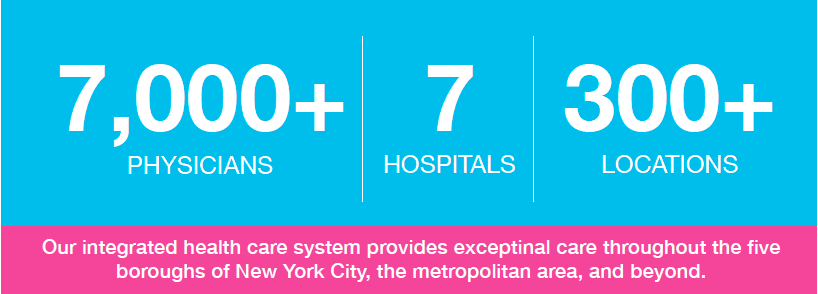MOUNT SINAI
MOUNT SINAI HEALTH SYSTEM

Health System Integration
Mount Sinai and Continuum Health Partners have combined to form the Mount Sinai Health System. The combination took some months in planning, and with the completion of the transaction in September 2013, Mount Sinai now looks to build on the strengths of both institutions to create a health system that stands as a national and global model of academic, clinical, and research excellence.

Facts and Figures
The Mount Sinai Health System combines the Icahn School of Medicine at Mount Sinai and seven hospital campuses to provide the highest quality health care throughout the New York metropolitan area:
Mount Sinai Beth Israel, Mount Sinai Brooklyn, The Mount Sinai Hospital, Mount Sinai Queens, Mount Sinai St. Luke’s, Mount Sinai West (formerly Mount Sinai Roosevelt), and New York Eye and Ear Infirmary of Mount Sinai.
Its integrated resources and expertise offer patients comprehensive care from birth through geriatrics, including complex cases.
This newly established system significantly expands Mount Sinai´s geographic footprint and increases the number of beds to 3,494.



Mount Sinai Health System Development Initiatives in Progress
The Mount Sinai Health System Office of Development is working on the combination of eight entities—the Icahn School of Medicine at Mount Sinai and the seven member hospitals—into a single philanthropic enterprise.
Information Technology at Mount Sinai Health System
The Information Technology (IT) department of the Mount Sinai Health System transforms and supports excellence in patient care, research, and education through a unified team that advances science and medicine with innovative leading-edge solutions.
We are focused on providing robust, scalable, innovative, and secure IT solutions across the Mount Sinai Health System, with a common experience for physicians, faculty, students, staff, and patients. We also recognize that transforming data into actionable information and knowledge is key to achieving the mission of the Health System.
In the future, our goal is to have a single patient record no matter where in the Mount Sinai Health System a patient is seen. This enables better and safer care, and provides physicians and other providers with the information they need, when they need it.
Physicians
Clinical and operational leaders from across the Mount Sinai Health System have been assembling into integration workgroups to coordinate the myriad functions that were previously based at the individual facilities into an interoperable network of such functions. At the highest level of the organization, we have established the Quality Leadership Council (QLC) and the System Management Council (SMC).
Health care finance is changing too rapidly under forces beyond our control. Therefore, we must be able to respond and adapt just as rapidly, making operational integration essential. Furthermore, organizationally we will need to function simultaneously as individual hospitals and practices, as well as a coordinated health system. To do so, we must embrace the notion of matrix management.
Facilities
With 14 million square feet of space, the Mount Sinai Health System is one of the largest in the country.
Health Network
The Mount Sinai Health Network comprises a multitude of ambulatory sites, institutional affiliations, and clinical relationships designed to create a geographically broad-based health care delivery system across the entire continuum of care. Its goal is to ensure the highest quality health care for the populations served by Mount Sinai and its affiliated physicians or institutions.
The Mount Sinai Health Network is continuously developing high quality clinical relationships and ambulatory practices outside of our main campuses to provide excellent health care at a community level, with ties to the advanced care that is available throughout the Health System. Mount Sinai has opened or acquired practices in Brooklyn, Nassau County, Manhattan, and Staten Island, tailoring the offering of clinical services to the specific needs of the area they serve. In addition, the Network is continually working to develop important clinical relationships with institutions that provide high quality health care in an effort to create important linkages in both an academic and clinical capacity.
The Future Mount Sinai Health Networ
In order to create a fully operational health care delivery system with an increasingly abundant geographic reach in New York, the Mount Sinai Health Network seeks to achieve many important goals. Our ability to ensure highest quality of care for the populations served by Mount Sinai and its affiliated physicians or institutions, and leverage the world-class academic programs of the Icahn School of Medicine at Mount Sinai to innovate patient care, is essential to the success of the Network.
Mount Sinai is consistently assessing the promotional and operational needs for each of our growing list of ambulatory practices, clinical affiliates, and relationships. Each member of the Network is an integral part of the Mount Sinai Health System and critical in our ability to elevate the care each patient receives.
Medical Education
The expansion of the Mount Sinai Health System to include Mount Sinai Beth Israel, Mount Sinai Beth Israel Brooklyn, Mount Sinai Roosevelt, Mount Sinai St. Luke’s, and New York Eye and Ear Infirmary of Mount Sinai, will be of enormous benefit to students at the Icahn School of Medicine at Mount Sinai (ISMMS).
Effect of the Integration on Medical Students
The expanded Health System makes us the largest in New York State and one of the largest in the country, and will provide clinical teaching, research, and career mentorship opportunities in every community in the city. Student access to diverse patient populations through a variety of environments including community hospitals, academic medical centers, and neighborhood health care providers, will be greatly enhanced, as will the quality of clinical teaching in these hospitals. This will ultimately affect all our clinical teaching venues, including ASM, LCE, InterACT, required Clerkships, and elective rotations.
Currently, the Icahn School of Medicine electives management system includes offerings throughout all sites in the Health System. Students can register for specific electives or create their own tailor-made experiences at Mount Sinai Beth Israel, Mount Sinai Roosevelt, and Mount Sinai St. Luke’s.
ICAHN SCHOOL OF MEDICINE AT MOUNT SINAI:
The Icahn School of Medicine at Mount Sinai (ISMMS) is an international leader in medical and scientific training, biomedical research, and patient care. It is the medical school for the Mount Sinai Health System.
Its unwavering pursuit of intellectual exchange, breakthrough research, and multidisciplinary teamwork propels ISMMS ever forward in biomedical discoveries and advances. The ICAHN SCHOOL pursues ideas that often challenge conventional wisdom to revolutionize the practice of medicine and produce dramatically better outcomes for patients. ISMMS makes big, bold bets by investing in radical free thinkers and technology at the cutting edge.
The Icahn School of Medicine at Mount Sinai is led by Dean Dennis S. Charney, MD. Chartered in 1963, it is the sole medical school for the Mount Sinai Health System which comprises seven hospital campuses and numerous ambulatory centers.
World renowned for its groundbreaking medical and scientific inquiry, discovery, and development, the Icahn School of Medicine at Mount Sinai is home to a full spectrum of research laboratories, institutes, and centers across all disciplines. Its researchers receive some of the highest NIH funding in the country.
Investigators at the Icahn School of Medicine at Mount Sinai (ISMMS) conduct basic, clinical, epidemiologic, and translational research, striving to rapidly transform scientific advances into improved patient care and outcomes. Through its progressive, patient-focused research and a history rich in clinical milestones, it has pioneered breakthroughs that have improved and saved countless lives.
The Icahn School embraces the idea that scientific revolutions, like technological revolutions, occur when we pursue big ideas, challenge the conventional wisdom and speed the pace of discovery. The ISMMS is an engine of discovery, with a mission to create new treatments for the patients who need them most, curing diseases once thought incurable and helping people worldwide.


